在《鎧甲橋》的公告板上,引用了谷崎潤一郎的《幼年時代》。在這個引用部分的前後,很好地描寫了周邊的風景。
鎧甲橋是1872年(1872年)架橋。1888年(1888年),市電被架設在鋼骨製的托拉斯橋上,從大正到昭和在橋上行駛過。1957年(1957年)架設在現在的東西上(《知識百科》;26)。 《幼年時代》是從1955年(1955年)4月到次年3月在雜誌《文藝春秋》上連載的,所以“鎧甲橋老化被拆除了”,這是在這個更換之前的事吧。
谷崎家在短時間內轉移到浜町後,轉移到了南茅場町。
引用了《幼年時代》的鎧甲橋說明版
我只在浜町的家裡花了幾個月,到1891年秋為止,好像轉移到了南茅場町的四十五號。・・・・・
・・・・小時候聽說過“鎧甲橋以前叫做鎧甲的交付,明天這裡沒有橋”,但是現在下游建了一座叫茅場橋的橋,鎧甲橋因為老化而被拆除了,所以才恢復到了我沒能生的以前。
從小網町來過原來的鎧甲橋,右邊有兜町的證券交易所,左邊的第一條路叫表茅場町,並行的下一條路叫做裡茅場町。・・・・・・・
即使來到茅場町,也不會被母親和老奶奶帶去每天去本家玩。距離和浜町的時候差不多,大約五六丁吧。從裡茅場町出發,從勝見的橫丁到表茅場町,穿過鎧甲橋向小網町方向左轉,然後馬上右轉,穿過米屋町。我和老奶奶的腳也只有十五分鐘左右的路,雖然是沒有電車和汽車的時代,但是越過鎧甲橋的時候必須要走向寬廣往來的一側的人道,所以為了不被人力車軋,老奶奶拼命地注意了我。那時的橋比路面高一層,有坡度,從橋上跑下來的人力車因為惰性而不能急停車,意外地發生了危險的事情。鎧甲橋是當時市中不多的鐵橋之一,我覺得新大橋和永代橋等還是古老的木橋。我往常在橋的中途停下來,眺望日本橋川的水流,但是我把臉強加在鐵欄杆上,注視著橋下出現的水的面,看上去不是水流去,而是橋在移動。我又從茅場町渡過,總是懷著不可思議的心情,看著位於上游兜町岸邊的澀澤邸的像伽說唱一樣的建築物。現在明天到處建著日證大廈,原本在那條河邊的出來鼻上,正好與石崖接壤,威尼斯風的走廊和有柱子的哥特式的殿堂在水中建著。在明治中期的東京正中央,誰的想法建立了那樣異國古典愛好的邸宅呢。對岸的小網町河岸上排列著幾棟倉庫的白壁,在那頭鼻子稍微拐一下就馬上就是江戶橋和日本橋,只有那一個廓像石板印刷的西洋風景畫一樣,散發著遠離日本的空氣。但是,與周圍的水之街並不一定是不釣到的,從前面的水流中來往的貨足船、傳馬船、達磨船等,和纜車一樣和諧,真是太妙了。(《南茅場町的第一家》;73)
We lived at the house in Hama-cho for only a few months, moving to No.45, Minami Kayaba-cho, sometime before the autumn of 1891. ・・・・・・
I remember being told as a child that there had been a ferry-crossing where Yoroibashi bridge then was; now the bridge is gone again, torn down because of dilapidation and replaced with the new Kayababashi bridge further downstream. Thus in a sense we have come full circle, back to what things were like in the old days, before I was born.
Coming from the direction of Koami-cho, at the point where the old Yoroibashi bridge crossed the river, you saw the Kabuto-cho stock exchange on the right. The first road to the left was called Kayaba-cho 'Front Street', while the next, paralleled to it, was 'Back Street'. ・・・・・
Even after the move to Minami Kayaba-cho, I still went almost daily to visit the main house with Mother and Granny. The distance was no more than it had been when we were in Hama-cho ―some five or six blocks. We passed from 'Back' to 'Front' Kayaba-cho vis the Katsumi side street; crossed Yoroibashi bridge and turned left toward Koami-cho; then turned right and passed thorough the rice dealers' district. It took only fifteen
minutes, even for Granny and me. There were as yet no streetcars or automobiles about, but Granny always warned me to be careful not to be hit by a rickshaw as I crossed the wide road beyond Yoroibashi bridge to get to the pavement on the other side.
The bridge was at that time raised somewhat higher than the surface of the road, and sloped down to meet it; and the rikishaws that sped down the slope often found it impossible to make sudden stops, so it could be quite dangerous. Yoroibashi was one of the not-so-numerous steel bridges then in Tokyo, while Shin Ohashi and Eitaibashi bridges were still made of wood. I used to stand in the middle of it and watch the flow of the Nihombashi River. As I pressed my face against the iron railings and gazed down at the surface of the water, it seemed as if it were the bridge and not the river that was moving.
Crossing the bridge from Kayaba-cho, one could see the fantastic Shibusawa mansion rising like a fairly-tale palace on the banks of Kabutocho, further upstream. There, where the Nissho Building now stands, the Gothic-style mansion with its Venetian galleries and pillars stood facing the river, its walls rising from the stony cliff of the small promontory on which it had been built. Whose idea was it, I wonder, to construct such an exotically traditional Western-style residence right in the middle of late nineteenth-century Tokyo? I never tired of gazing at its romantic outlines with a kind of rapture. Across the river on the Koami-cho embankment were lined the white walls of innumerable storehouses. Though the Edobashi and Nihombashi bridges stood just beyond the promontory, this little section of Sitamachi had a foreign air, like some scenic lithograph of Europe. Yet it did not clash with the river and surrounding buildings-in fact, the various old-fashioned barges and lighters that moved up and down the stream past the 'palace' were strangely in harmony with it, like gondolas moving on a Venetian canal・・・ (54)
鎧甲的交付痕跡的說明版,渡口一直持續到1872年(1872年)架設鎧甲橋為止。(《知識百科》;25)
從鎧甲橋上面臨茅場橋。這座橋的南端附近,以前被稱為茅場河岸,是切茅草堆起來的放置場所。和今天茅場町的由來一樣,橋名也由此而來。現在的橋是由於舊橋的老化而在1992年(1992年)架設的(《知識百科》;25)。
從日本橋小網町越過鎧甲橋面臨證券交易所
前面是日證館大樓,前面的樹木是兜神社,前面的高層建築是日本橋鑽石大廈
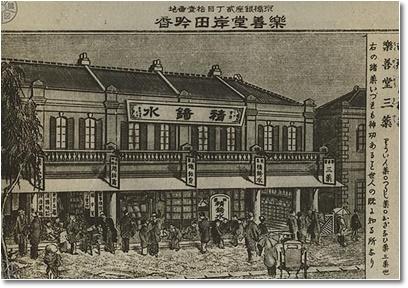
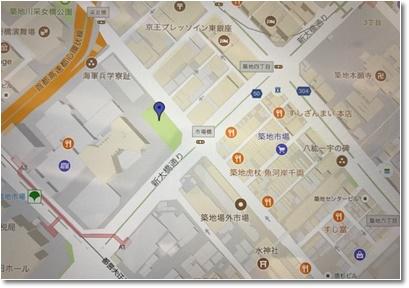
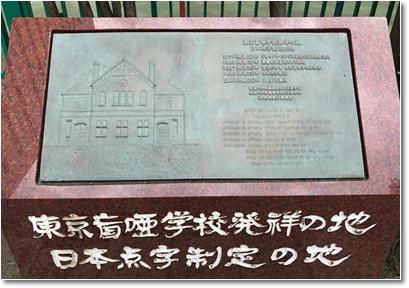



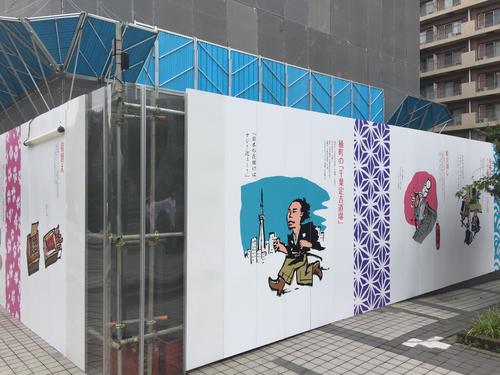
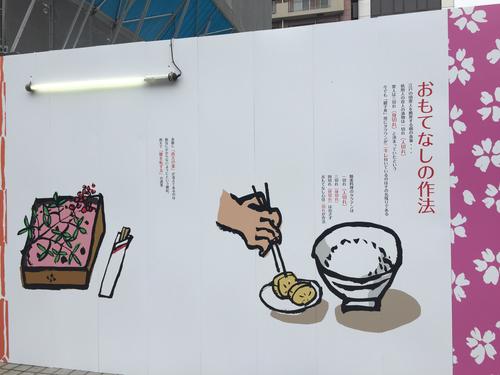
![IMG_2091[1].JPG](https://tw.tokuhain.chuo-kanko.or.jp/archive/assets_c/2017/09/IMG_2091%5B1%5D-thumb-500xauto-47209.jpg)
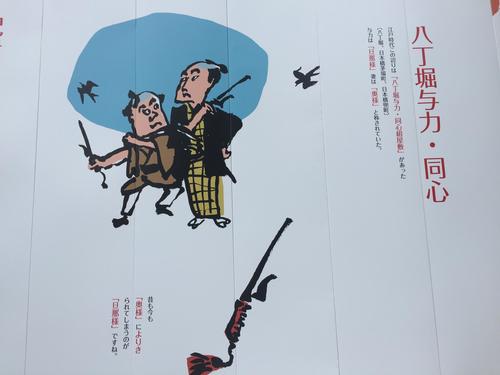
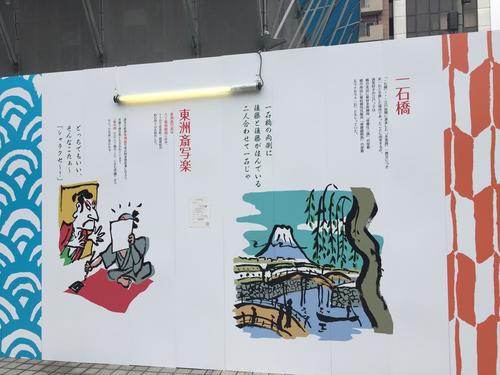
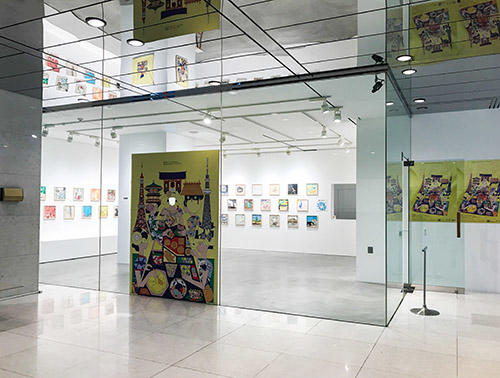
 場內是這樣的,每個房間都有描寫的區域。
場內是這樣的,每個房間都有描寫的區域。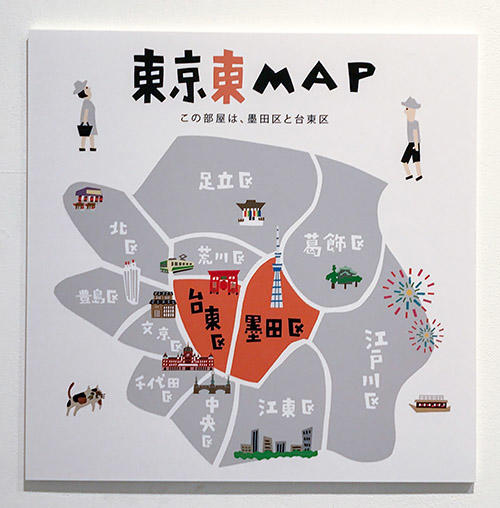 大家喜歡的區域,住的區域,哪個插圖畫家是怎麼表現的呢!在看很多漂亮的畫的時候也有想起的景色和活動,“久違地去那裡看看吧...”這樣的心情。
大家喜歡的區域,住的區域,哪個插圖畫家是怎麼表現的呢!在看很多漂亮的畫的時候也有想起的景色和活動,“久違地去那裡看看吧...”這樣的心情。
